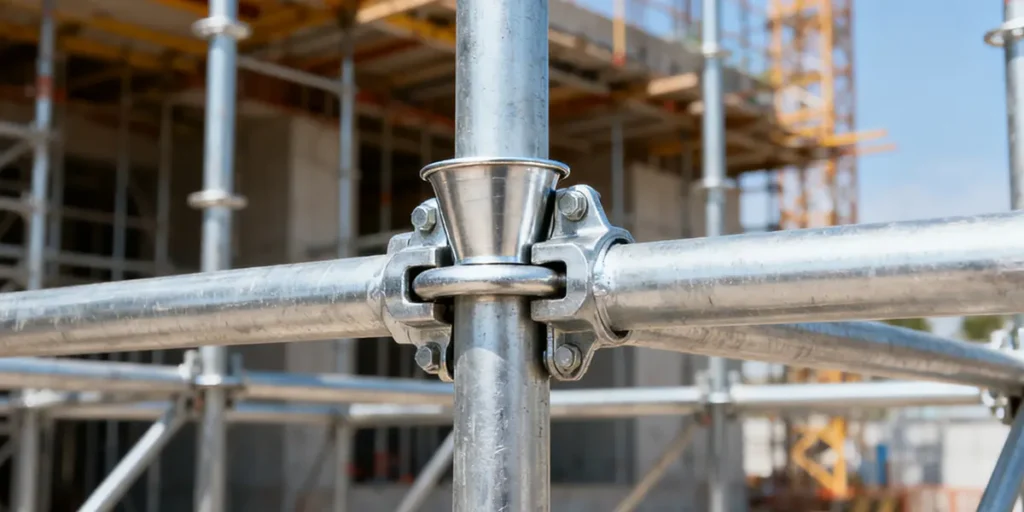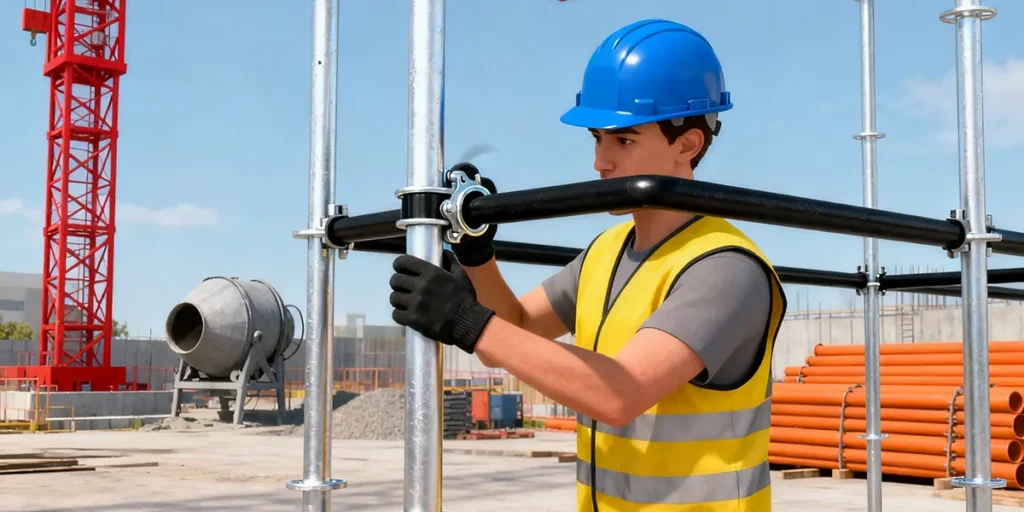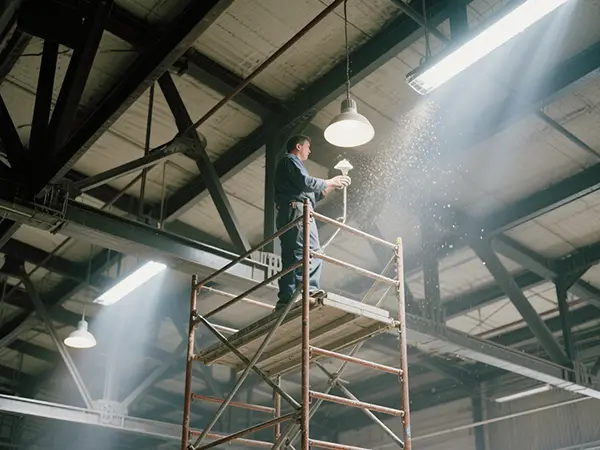Cuplock scaffolding is one of the most popular scaffolding systems used in construction projects worldwide. As a modular scaffolding system characterized by its unique cup-shaped locking components, it has gained widespread adoption for its efficiency and reliability. But how safe is cuplock scaffolding exactly? This question is crucial for construction managers, contractors, and safety inspectors who prioritize workplace safety. The safety of cuplock scaffolding depends on multiple factors including proper installation, adherence to load specifications, regular inspections, and compliance with safety standards. When these elements are properly addressed, cuplock scaffolding demonstrates an excellent safety record that meets rigorous international standards. In this comprehensive article, we will examine the various safety aspects of cuplock scaffolding systems, from their inherent design advantages to mandatory safety protocols that ensure secure working platforms for construction projects.

Understanding Cuplock Scaffolding System
What Is Cuplock Scaffolding?
Cuplock scaffolding is a type of modular scaffolding system that uses a unique cup-shaped locking mechanism to connect horizontal and vertical components. The system consists of three main elements: vertical standards (uprights), horizontal ledgers, and the distinctive fork-shaped blade that fits into the cups welded to the standards at regular intervals. The connection is secured by driving an upper cup downward to lock the blade in place, creating a rigid joint without the need for loose components. This innovative design originated from British scaffolding systems but has since been adapted and standardized in many countries, including China where the JGJ 166-2016 standard specifically governs its application.
The cuplock system is designed for quick assembly and disassembly, significantly reducing labor time compared to traditional tube-and-coupler scaffolding. The standardized components allow for consistent installation quality, minimizing human error that often compromises scaffolding safety. According to construction safety statistics, properly installed cuplock systems have demonstrated superior structural integrity compared to many alternative scaffolding solutions.
Key Components and Their Safety Features
The safety of cuplock scaffolding begins with its components. Each part is engineered to contribute to the overall stability and load-bearing capacity of the system:
- Vertical Standards: These upright tubes are typically made from high-strength steel (Q235 or Q345 grade in Chinese standards) and feature welded cups at fixed intervals, usually 500mm or 600mm apart. The cups serve as connection points for horizontal members and are designed to distribute loads evenly across the structure.
- Horizontal Ledgers: These transverse members connect between standards using forged blades at their ends that fit precisely into the cups. The interlocking mechanism creates a rigid connection that resists movement in all directions.
- Special Components: The system includes specialized elements like diagonal braces, base jacks, adjustable U-heads, and ladder units that enhance stability and functionality. Diagonal bracing is particularly crucial for preventing lateral movement and maintaining geometric stability under load and environmental stresses.
The materials used in cuplock scaffolding undergo rigorous quality control. According to the JGJ 166-2016 standard, steel components must meet specific mechanical properties, and the galvanized coating provides corrosion resistance, extending the scaffold’s lifespan while maintaining structural integrity.
The Safety Features of Cuplock Scaffolding
Design Advantages for Enhanced Safety
The cuplock scaffolding system incorporates several design features that inherently enhance its safety performance:
- Rigid Node Connections: The cup-and-blade locking mechanism creates semi-rigid connections that provide excellent moment resistance compared to traditional coupler systems. This structural characteristic significantly reduces the risk of accidental collapse when properly installed.
- Standardized Modular Design: The standardized nature of the system ensures consistent performance and eliminates guesswork during assembly. The predefined connection points prevent incorrect installations that could compromise structural integrity.
- Multi-directional Load Distribution: The node design allows each connection point to accommodate up to four horizontal members simultaneously, creating a three-dimensional grid that effectively distributes loads throughout the structure.
- Integrated Safety Systems: Modern cuplock systems can be equipped with integrated guardrails, toe boards, and ladder access points that further enhance worker safety during assembly and use.
The structural design of cuplock scaffolding has evolved through years of practical application and refinement. The current Chinese standard JGJ 166-2016 incorporates lessons learned from extensive use in various construction scenarios, resulting in improved safety factors and design methodologies.
Load-Bearing Capacity and Structural Integrity
One of the most critical safety aspects of any scaffolding system is its load-bearing capacity. Cuplock scaffolding demonstrates impressive load-bearing characteristics when installed according to manufacturer specifications and relevant standards:
- Vertical Load Capacity: A single cuplock standard can typically support between 6,000 to 8,000 kg of vertical load, depending on the steel grade and wall thickness. The JGJ 166-2016 standard specifies detailed calculation methods for determining exact load capacities based on specific project conditions.
- Horizontal Load Resistance: The system’s ability to resist horizontal forces (such as wind loads) is enhanced by its modular design and the requirement for diagonal bracing at regular intervals.
- Working Platform Capacity: Properly installed cuplock scaffolding can typically support working loads of up to 75 pounds per square foot (psf) for medium-duty applications and up to 150 psf for heavy-duty applications when configured according to specifications.
The structural integrity of cuplock scaffolding is maintained through its nodal rigidity and the systematic arrangement of components. Research comparing different national standards has shown that cuplock systems designed according to established codes maintain significant safety margins under expected loading conditions.
International Safety Standards and Compliance
Key Safety Standards for Cuplock Scaffolding
Cuplock scaffolding safety is governed by various international standards and regulations that establish minimum safety requirements:
- Chinese Standard JGJ 166-2016: This is the primary standard governing cuplock scaffolding safety in China. It covers technical specifications for components, design requirements, construction methodologies, inspection protocols, and safety management. The standard includes mandatory provisions (highlighted in bold text) that must be strictly followed.
- British and European Standards: The BS EN 12810 standard provides comprehensive guidelines for cuplock scaffolding design and usage in European contexts, with specific load calculation methodologies and safety factors.
- OSHA Regulations: While primarily focused on general scaffolding safety, OSHA standards (29 CFR 1926.452) include specific requirements for mobile scaffold systems that share some characteristics with cuplock systems.
A comparative study between Chinese and British design codes revealed some differences in approach but consistent emphasis on safety margins and structural reliability. Understanding these standards is crucial for ensuring compliance and maintaining safety across different regional contexts.
Mandatory Safety Provisions in Cuplock Standards
The JGJ 166-2016 standard identifies several mandatory provisions that are critical for ensuring cuplock scaffolding safety. These include:
- Strict Prohibition on Overloading: Article 9.0.3 explicitly states that “the construction load on the scaffold working platform must not exceed the design allowable load”. This provision prevents the common practice of overloading working platforms with excessive materials or equipment.
- Proper Tie-in Requirements: The standard mandates regular attachment of the scaffold to the supporting structure through appropriate tie-ins, preventing collapse due to lateral forces.
- Specific Demolition Procedures: Article 7.4.7 requires that “scaffold dismantling must proceed from top to bottom, with each story removed separately. Tie-ins must be removed along with the corresponding scaffold level, not in advance”. This prevents destabilization during demolition.
- Prohibition of Unauthorized Modifications: Article 9.0.11 forbids the removal of any primary structural elements including horizontal members, ledger beams, or tie-ins during use.
These mandatory provisions address the most common causes of scaffolding accidents and form the foundation of a comprehensive safety strategy for cuplock systems.

Proper Installation and Usage Guidelines
Correct Installation Procedures
Proper installation is perhaps the most critical factor in ensuring cuplock scaffolding safety. The following installation sequence and guidelines help maintain structural integrity:
- Foundation Preparation: The supporting surface must be capable of bearing the anticipated loads without excessive settlement. Base jacks should be used to compensate for uneven grades and ensure vertical alignment of standards.
- Initial Assembly: Installation begins with setting up the corner standards and establishing the first bay. Subsequent standards are then positioned and connected with ledgers to form a stable grid.
- Level-by-Level Erection: The scaffold should be erected one complete level at a time, with all connections properly locked before proceeding to the next level.
- Bracing Installation: Diagonal bracing must be installed according to the design specifications, typically in a continuous pattern from base to top at predetermined intervals.
- Platform Installation: Working platforms consisting of scaffold boards or manufactured decks must be properly secured and extend across the entire bay width.
- Safety Features Installation: Guardrails, toe boards, and access ladders must be installed as the scaffold rises to protect workers during both construction and use.
The JGJ 166-2016 standard provides detailed installation requirements, emphasizing the importance of following manufacturer guidelines and design specifications.
Common Installation Errors and Their Consequences
Many scaffolding failures can be traced to errors during installation. The most common mistakes with cuplock scaffolding include:
- Inadequate Foundation Support: Placing scaffold standards on unstable or unprepared ground can lead to settlement and collapse.
- Missing or Improperly Installed Bracing: Diagonal bracing is essential for lateral stability; omitting or incorrectly installing braces significantly reduces the scaffold’s resistance to horizontal forces.
- Incomplete Connections: Failure to properly lock all cup connections compromises the structural rigidity of the entire system.
- Improper Component Substitution: Using non-compatible or substandard components undermines the engineered safety factors of the system.
- Excessive Height-to-Base Ratios: Exceeding recommended ratios without additional stabilization can create instability risks.
Awareness of these common errors enables proactive identification and correction of potential safety issues before they lead to accidents.
Risk Factors and Safety Considerations
Potential Hazards and Mitigation Strategies
While cuplock scaffolding is inherently safe when properly installed and maintained, several risk factors require careful management:
- Environmental Factors: Wind, rain, snow, and temperature extremes can affect scaffold stability. Wind in particular can generate significant lateral forces that must be accounted for in the design. The JGJ 166-2016 standard includes specific calculation methods for wind loads.
- Material Degradation: Corrosion, physical damage, or wear of components can compromise structural integrity. Regular inspection and maintenance programs are essential for identifying and removing compromised elements from service.
- Human Factors: Worker error during assembly, modification, or use represents a significant risk category. Comprehensive training and supervision are crucial for mitigating these risks.
- Dynamic Loads: Sudden impacts from moving equipment, material handling, or personnel movement can induce dynamic effects beyond static design calculations. Operational protocols should minimize such dynamic effects.
The comparative study between Chinese and British codes highlighted that different standards may approach these risk factors with varying methodologies, but all prioritize maintaining adequate safety margins.
Special Considerations for Mobile Cuplock Scaffolding
When cuplock systems are mounted on casters for mobility, additional safety considerations apply:
- Caster Locking Mechanisms: OSHA requirements mandate that “when performing tasks, the casters/wheels must be locked”. This prevents unintended movement during work operations.
- Height-to-Base Ratio Limitations: Mobile scaffolds typically have strict limitations on height relative to base dimensions to prevent tipping.
- Stabilizer Deployment: Outriggers or stabilizers may be required for taller mobile installations to increase the base dimension and enhance stability.
- Movement Procedures: Specific protocols must be established for moving mobile scaffolds, including ensuring the path is clear of obstructions and verifying that no workers remain on the platform during relocation (unless specifically designed for this purpose).
Inspection and Maintenance Protocols
Regular Inspection Requirements
Consistent, thorough inspection is fundamental to maintaining cuplock scaffolding safety. The JGJ 166-2016 standard mandates specific inspection protocols:
- Pre-use Inspection: A complete visual inspection must be conducted before placing the scaffold into service, verifying that all components are present, properly installed, and in good condition.
- Periodic Inspections: Regular inspections must continue at predetermined intervals during use, typically at least weekly, with documentation maintained for each inspection.
- Post-event Inspections: After any occurrence that might affect structural integrity (severe weather, impact damage, significant loading events), an immediate inspection must be conducted.
- Component Inspection: Individual components should be periodically checked for damage, corrosion, or deformation that could compromise performance.
Inspection checklists should include verification of proper connections, assessment of foundation stability, confirmation of bracing installation, evaluation of access safety, and documentation of any identified issues with corrective actions.
Maintenance and Component Management
Proper maintenance ensures the long-term safety and performance of cuplock scaffolding systems:
- Cleaning Procedures: Regular removal of construction debris, mud, or other materials that might interfere with connections or promote corrosion.
- Corrosion Protection: Periodic inspection of galvanized coatings and timely repair of damaged areas to prevent section loss due to rust.
- Component Tracking: Establishment of a system to identify and remove damaged components from service, preventing their accidental reuse.
- Storage Practices: Proper storage conditions that minimize environmental exposure and prevent physical damage to components.
The manufacturer’s recommendations for maintenance should be followed explicitly, as improper cleaning methods or repair techniques can inadvertently damage components or protective coatings.
Comparison with Other Scaffolding Systems
Safety Advantages Over Alternative Systems
Cuplock scaffolding offers several safety advantages compared to other common scaffolding systems:
- Enhanced Connection Reliability: Unlike tube-and-coupler systems that rely on bolt tightness and worker skill for connection integrity, the cuplock mechanism provides consistent, verifiable connections that are less susceptible to improper installation.
- Reduced Loose Components: The integrated connection system minimizes loose parts that can be dropped, lost, or improperly installed—common issues with coupler-based systems.
- Predictable Performance: The standardized design and engineering of cuplock systems result in more predictable structural performance compared to systems with greater assembly variability.
- Fault Identification: Missing or incomplete connections are generally more visible in cuplock systems, allowing for easier identification of installation errors during inspection.
A comparative analysis published in academic literature noted that cuplock systems designed according to established codes generally demonstrate reliable safety performance when properly implemented.
Limitations and Appropriate Applications
While cuplock scaffolding offers significant safety advantages, it also has limitations that affect its appropriate application:
- Geometric Constraints: The fixed node spacing (typically 500mm or 600mm) may not ideally suit all structural geometries, potentially requiring adaptation or supplemental systems for complex shapes.
- Accessibility Challenges: In confined spaces or areas with significant obstructions, the modular nature of cuplock systems may present installation difficulties.
- Cost Considerations: While offering labor savings during erection and dismantling, the initial investment in cuplock components may be higher than traditional systems.
Understanding these limitations helps in selecting the appropriate scaffolding system for specific project conditions, which is itself a critical safety decision.
YoConclusion
Cuplock scaffolding, when properly designed, installed, and maintained according to recognized safety standards like JGJ 166-2016, represents one of the safest scaffolding systems available to the construction industry. Its inherent safety advantages stem from its modular design, reliable connection system, and predictable structural behavior. The system’s safety record, when implemented correctly, demonstrates its suitability for a wide range of construction applications.
The key to ensuring cuplock scaffolding safety lies in strict adherence to established standards, comprehensive worker training, diligent inspection protocols, and responsible maintenance practices. By addressing all these elements systematically, construction professionals can leverage the safety benefits of cuplock scaffolding while minimizing risks to workers and the public.
As with any structural system, complacency represents the greatest threat to safety. Even with the engineered advantages of cuplock scaffolding, continuous attention to proper procedures, load management, and environmental factors remains essential for maintaining safe working conditions throughout the project lifecycle.


